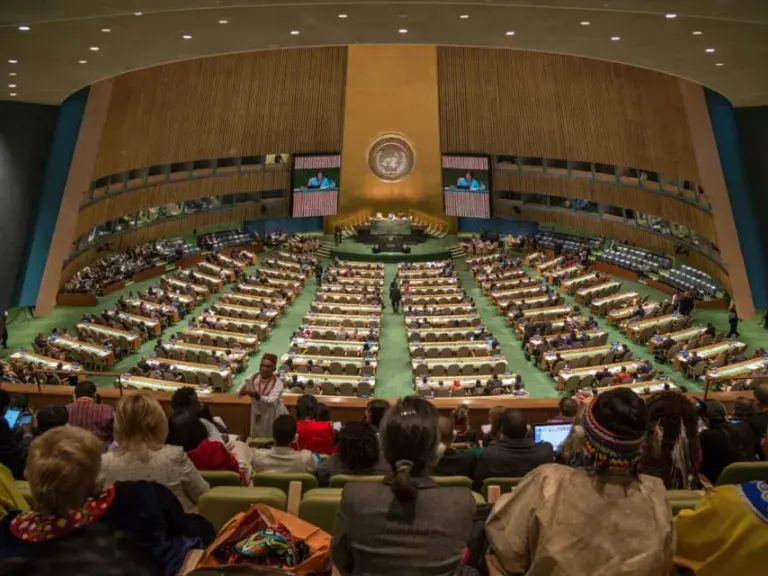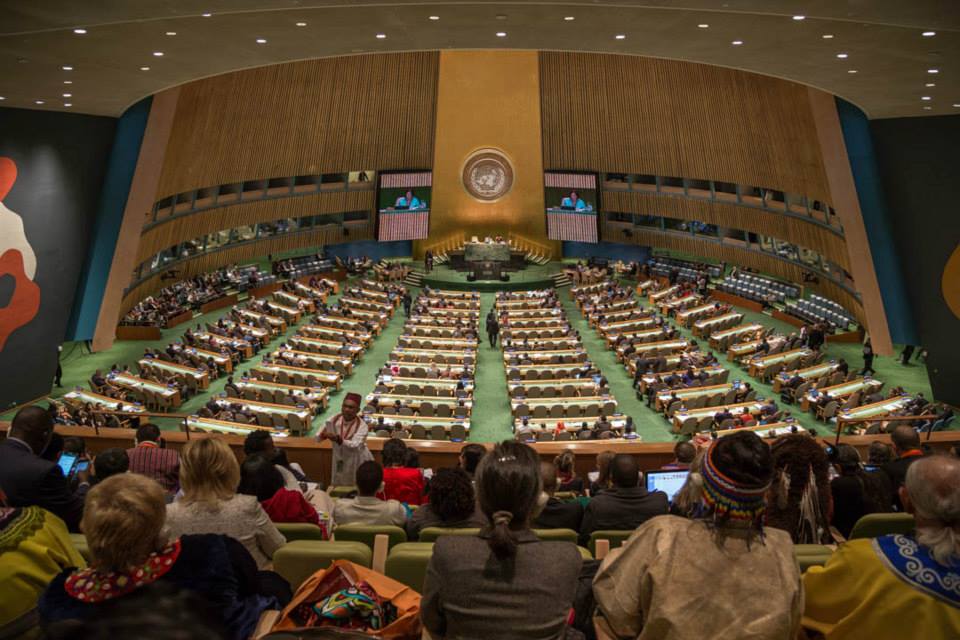
 April 25, 2017 (NEW YORK CITY) — It is hard to believe that on September 13, 2017, a decade will have passed since the United Nations adopted the Declaration on the Rights of Indigenous Peoples. The Declaration remains the most significant development in international human rights law in decades, and it has sparked important conversations and actions regarding indigenous peoples’ rights, including rights of self-determination and self-government, rights to land and resources, and protection of cultures and languages.
April 25, 2017 (NEW YORK CITY) — It is hard to believe that on September 13, 2017, a decade will have passed since the United Nations adopted the Declaration on the Rights of Indigenous Peoples. The Declaration remains the most significant development in international human rights law in decades, and it has sparked important conversations and actions regarding indigenous peoples’ rights, including rights of self-determination and self-government, rights to land and resources, and protection of cultures and languages.
This week, the President of the 71st session of the UN General Assembly is holding a high-level event in New York City to mark the 10th anniversary of the adoption of the Declaration. The event will take stock of the achievements since 2007, assess the remaining challenges for the rights of indigenous peoples, and also examine further follow-up to the Declaration, including the consideration of a third International Decade on the World’s Indigenous Peoples to strengthen international cooperation on solving these lingering challenges.
The Center is proud to have been a part of the process for the 30 years leading up to the adoption of the Declaration. From 1977 to 2007, we advocated for a human rights instrument that would at last protect the rights of indigenous peoples and provide them a permanent place in the international community. Over the last ten years, we have continued our work to ensure the promises in the Declaration are realized and, in spite of some challenges, we have seen some good progress in laws, policies, and practices locally and internationally.
In the United States:
- Since 2009, the United States has held an annual White House Tribal Nations Conference in Washington, DC, a government-to-government consultation among the various agencies and departments of the United States and tribal leaders.
- Development of federal agency and departmental policies referencing or advancing provisions of the UN Declaration, including:
- the Memorandum of Understanding among various departments to improve interagency coordination and collaboration for the protection of sacred sites in 2012;
- the Advisory Council on Historic Preservation’s plan to support the Declaration in 2013 ;
- the Department of Justice Attorney General’s Guidelines Stating Principles for Working with Federally Recognized Tribes in 2014;
- the Environmental Protection Agency’s Policy on Environmental Justice for Working with Federally Recognized Tribes and Indigenous Peoples in 2014;
- the Fish and Wildlife Service’s Native American Policy in 2016; and
- the Department of State’s draft Tribal Consultation Policy in 2017.
- In 2013, the establishment of the White House Council on Native American Affairs to ensure the collaboration and coordination across federal agencies and departments with tribal leadership.
- Important legislation to advance and protect the sovereignty of tribal nations such as the 2010 Tribal Law and Order Act, the 2013 Violence Against Women Reauthorization Act and the subsequent repeal of its Section 910 which had excluded Alaska Native Villages from many key protections, and the 2014 Tribal General Welfare Exclusion Act.
- Decisions by the judiciary in cases such as Dollar General and Akiachak, which, respectively, uphold tribal authority to exercise civil jurisdiction over non-Indian offenders and the Bureau of Indian Affairs’ authority to take lands into trust for Alaska Native tribes.
In North America:
- In 2016, the establishment of the trilateral North American Working Group on Violence Against Indigenous Women and Girls, comprised of the United States, Canada, and Mexico. The Working Group will host an event on April 24, 2017, “Eliminating Violence Against Indigenous Women and Girls Through Empowerment” on the margins of the United Nations Permanent Forum on Indigenous Issues annual session in New York, April 24-May 5, 2017.
In the United Nations:
- Over 150 Indian nations and organizations throughout the Americas joined together to win four key commitments at the UN World Conference on Indigenous Peoples in 2014: to develop an expert body capable of monitoring countries compliance with, and responding to violations of, the UN Declaration; to enable the participation of indigenous governments at the UN; and to advance protections for native women and children and sacred sites.
- Since 2014, indigenous leaders have been hard at work to see the World Conference commitments come to fruition.
- In 2016, the Human Rights Council decided to repurpose an existing body – the Expert Mechanism on the Rights of Indigenous Peoples (EMRIP). EMRIP now has the authority to seek and gather information from all sources including by country visits, to advise and assist member states regarding its domestic laws and policies and implementation of treaty body and other international human rights recommendations, and to prepare reports to the Human Rights Council and conduct studies on efforts to achieve the ends of the Declaration. All of these activities are essential to any international implementing and monitoring body. The Mechanism is now developing its methods of work before it meets in Geneva, Switzerland for its annual session, July 10-14, 2017.
- To enable the participation of indigenous governments at the UN, the President of the General Assembly held several consultations among member states and indigenous peoples in 2016 and 2017, and is now in the process of finalizing a UN text on the matter, which could occur as early as June, 2017.
- And the UN continues to dedicate much needed attention to the serious issues of protecting sacred sites and ending violence against indigenous and children. In 2016, the Human Rights Council dedicated two panels and two resolutions to the issue of violence against indigenous women and girls, and in 2017, the Commission on the Status of Women identified the empowerment of indigenous women as its focus area for its annual session, held March 13-24 in New York.
The work to implement all of the aspects of the Declaration is far from over. We encourage indigenous leaders and tribes to engage in the UN process, and we welcome the opportunity to support their efforts. For more information about our work visit www.indianlaw.org/wcip.
